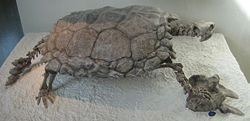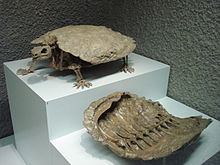- Proganochelys
-
Proganochelys
Temporal range: Late Triassic, 210 Ma
Skeleton of Proganochelys quenstedti, American Museum of Natural History Scientific classification Kingdom: Animalia Phylum: Chordata Class: Sauropsida Order: Testudines Family: Proganochelidae Genus: Proganochelys Species: P. quenstedti Binomial name Proganochelys quenstedti
Baur, 1887Proganochelys quenstedti is the second oldest turtle species discovered to date, known only from fossils found in Germany and Thailand in strata from the late Triassic, dating to approximately 210 million years ago. It has several synonyms, including Chelytherium ("Turtle Beast"), Psammochelys ("Sand Turtle"), Stegochelys ("Roof Turtle") and Triassochelys ("Triassic Turtle").
Until 2008, when the 220 million year old Odontochelys was discovered, Proganochelys was the oldest known turtle species.
Palaeobiology
In life it was about 1 metre (3.3 ft) long, its overall appearance resembling modern turtles in many respects: it lacked teeth, likely had a beak, and had the characteristic heavily armored shell formed from bony plates and ribs which fused together into a solid cage around the internal organs. The plates comprising the carapace and plastron were already in the modern form, although there were additional plates along the margins of the shell, that would have served to protect the legs. Also unlike any modern species of turtle, its long tail had spikes and terminated in a club, its head could not be retracted under the shell, and its neck was protected by small spines. While it had no teeth in its jaws, it did have small denticles on the palate.[1]
References
External links
- American Museum of Natural History: Proganochelys
- Enchanted Learning Paleontology and Geology Glossary
- belated questions about beaks
- Animal Diversity Web: Order Testudines
Categories:- Extinct turtles
- Prehistoric reptiles of Europe
- Triassic turtles
Wikimedia Foundation. 2010.


